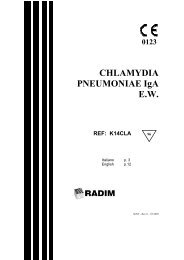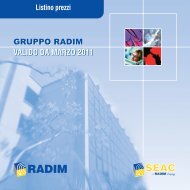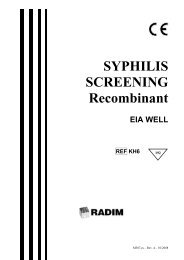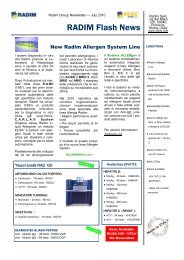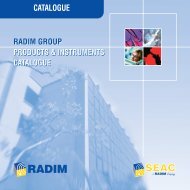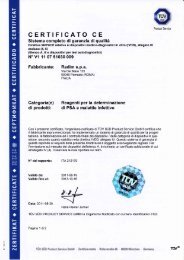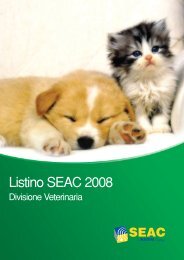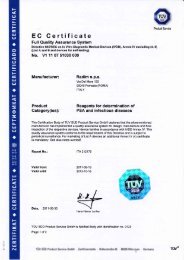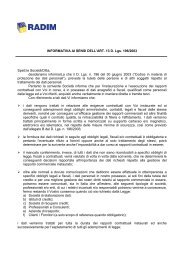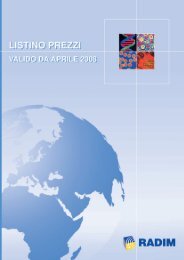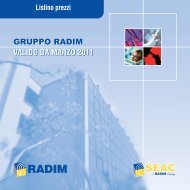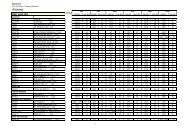CagA IgG EIA WELL REF K6HPG - Radim S.p.A.
CagA IgG EIA WELL REF K6HPG - Radim S.p.A.
CagA IgG EIA WELL REF K6HPG - Radim S.p.A.
You also want an ePaper? Increase the reach of your titles
YUMPU automatically turns print PDFs into web optimized ePapers that Google loves.
<strong>CagA</strong> <strong>IgG</strong> <strong>EIA</strong> <strong>WELL</strong><br />
<strong>REF</strong> <strong>K6HPG</strong><br />
96<br />
Italiano p. 3<br />
English p. 12<br />
M197 – Rev.9 – 06/2008 – Pag. 1/ 24
REAGENTI DEL KIT - KIT REAGENTS<br />
Reag. Quant.<br />
MTP<br />
1 x 96 Pronti per l'uso,<br />
Ready for use<br />
WASH<br />
1 x 50 mL Conc.<br />
DIL<br />
CAL<br />
CONJ<br />
TMB<br />
STOP<br />
1 x 20 mL Conc.<br />
6 x 1.5 mL Pronti per l'uso,<br />
Ready for use<br />
1 x 14 mL Pronto per l'uso,<br />
Ready for use<br />
2 x 15 mL Pronto per l'uso,<br />
Ready for use<br />
1 x 14 mL Pronto per l'uso,<br />
Ready for use<br />
"Le Istruzioni per l'uso tradotte nelle altre lingue di interesse sono consultabili sul sito<br />
Internet all'indirizzo www.radim.com".<br />
“The instructions for use available in the other languages of interest can be viewed on our<br />
website www.radim.com".<br />
“Οι οδηγίες χρήσης μεταφρασμένες στις άλλες ενδιαφερόμενες γλώσσες όπως επίσης στην<br />
ηλεκτρονική διεύθυνση www.radim.com".<br />
“In den anderen Sprachen von Interesse ist die Bedienungsanleitung kann auf der Website<br />
unter der Adresse www.radim.com konsultiertwerden”.<br />
"Le mode d’emploi dans les autres langues intéressées est consultable sur le site Internet à<br />
l'adresse www.radim.com”.<br />
“Las instrucciones de uso traducidas en los otros idiomas de interés se pueden consultar en<br />
nuestro sitio Internet www.radim.com”.<br />
"As instruções de uso traduzidas nos outros idiomas de interesse podem ser consultadas<br />
no nosso site Internet, ao endereço www.radim.com."<br />
<strong>K6HPG</strong> –<strong>CagA</strong> <strong>IgG</strong> <strong>EIA</strong> <strong>WELL</strong><br />
M197 – Rev.9 – 06/2008 – Pag. 2/ 24
DOSAGGIO IMMUNOENZIMATICO PER LA DETERMINAZIONE<br />
QUANTITATIVA DEGLI ANTICORPI <strong>IgG</strong> ANTI-<strong>CagA</strong> NEL SIERO O PLASMA<br />
UMANO.<br />
PER USO DIAGNOSTICO IN VITRO<br />
1. APPLICAZIONI CLINICHE<br />
L'Helicobacter pylori è un piccolo batterio gram-negativo, a forma di "S" che<br />
infetta la mucosa gastrica del 20-80% della popolazione umana. La prevalenza<br />
dell'infezione da H. pylori aumenta con l'età e dipende da diversi fattori, come la<br />
localizzazione geografica e il livello socioeconomico. Questo batterio provoca<br />
gastrite cronica e acuta, ulcera peptica, gastrite atrofica e si sospetta che abbia<br />
un ruolo nell'insorgenza dell'adenocarcinoma gastrico. L'infezione da H. pylori, se<br />
non viene eradicata con uno specifico trattamento antibiotico, persiste per tutta la<br />
vita. In pazienti con ulcera gastrica o duodenale, l'eradicazione dell'H. pylori<br />
produce una netta riduzione della frequenza di recidive. Tuttavia, sebbene<br />
pressoché tutte le persone infette sviluppino una gastrite, rimane ancora da<br />
chiarire il motivo per cui la maggior parte dei pazienti infettati da H. pylori rimane<br />
asintomatica, e solo in una minoranza di essi l'infezione porti ad una ulcera<br />
gastrica o duodenale. Ciò può essere dovuto sia a fattori propri dell'ospite (fumo,<br />
gruppo sanguigno 0, sesso maschile) sia all'eterogeneità dei ceppi di H. pylori. E'<br />
stato recentemente scoperto che circa il 50-60 % dei ceppi di H. pylori produce<br />
una citotossina vacuolizzante di 87 kDa (VacA) insieme ad una proteina<br />
fortemente antigenica di circa 120-128 kDa (<strong>CagA</strong>), mentre ceppi che non<br />
producono la citotossina hanno il gene che la codifica ma mancano del gene che<br />
codifica il <strong>CagA</strong>. Diversi studi hanno dimostrato che ceppi producenti la<br />
citotossina vengono isolati con frequenza maggiore da soggetti con ulcera peptica<br />
che da soggetti con dispepsia non ulcerativa. In studi sierologici, le <strong>IgG</strong> anti-<strong>CagA</strong><br />
sono state rilevate in pazienti infetti da H. pylori con ulcera peptica molto più<br />
frequentemente che in persone infette con semplice gastrite. Pertanto, la<br />
presenza di <strong>IgG</strong> anti-<strong>CagA</strong> nel siero del paziente indica una precedente infezione<br />
da H. pylori di ceppo <strong>CagA</strong> positivo, e la determinazione di questi anticorpi può<br />
utilmente indirizzare le decisioni terapeutiche.<br />
2. PRINCIPIO DEL METODO<br />
Il presente kit è basato sul metodo immunoenzimatico (ELISA) ed utilizza come<br />
marcatore enzimatico la perossidasi. Durante la prima incubazione, gli anticorpi<br />
anti-<strong>CagA</strong> della classe <strong>IgG</strong> eventualmente presenti nel campione in esame si<br />
legano all'antigene adeso alla superficie dei pozzetti. Tramite lavaggio viene<br />
eliminato il materiale non legato; in una successiva incubazione si fa reagire un<br />
secondo anticorpo (anti-<strong>IgG</strong> umane coniugate alla perossidasi) con il complesso<br />
formatosi tra antigene ed anticorpo anti-<strong>CagA</strong>. Dopo ulteriore lavaggio viene<br />
aggiunta una soluzione di Cromogeno incolore (tetrametilbenzidina, TMB) in<br />
Tampone Substrato, che reagendo con la perossidasi presente produce un<br />
composto colorato. La reazione di sviluppo del colore è bloccata con l'aggiunta di<br />
<strong>K6HPG</strong> –<strong>CagA</strong> <strong>IgG</strong> <strong>EIA</strong> <strong>WELL</strong><br />
M197 – Rev.9 – 06/2008 – Pag. 3/ 24
H2SO4 e l'intensità del colore, misurata mediante spettrofotometro a 450 e a 405<br />
nm, è direttamente proporzionale alla concentrazione di anticorpi <strong>IgG</strong> anti-<strong>CagA</strong><br />
presenti nei calibratori e nei campioni in esame.<br />
3. REAGENTI CONTENUTI NEL KIT: PREPARAZIONE E STABILITA'<br />
− I reagenti sono sufficienti per 96 pozzetti.<br />
− Il kit deve essere conservato a 2-8°C.<br />
− La data di scadenza di ciascun reagente è indicata sulla rispettiva etichetta.<br />
− Una volta aperto il kit è stabile 2 mesi a 2-8°C.<br />
3.1 Reagenti Specifici<br />
• MTP Micropiastra sensibilizzata: 1 micropiastra da 96 pozzetti, divisibili<br />
singolarmente, sensibilizzati con antigene <strong>CagA</strong> (ottenuto da DNA<br />
ricombinante). I pozzetti non utilizzati devono essere conservati a 2-8°C<br />
nella bustina di plastica trasparente fornita, sigillata accuratamente.<br />
• CAL Calibratori: 6 flaconi (1.5 mL) di <strong>IgG</strong> anti-<strong>CagA</strong> in matrice sierica alle<br />
seguenti concentrazioni: 0, 15, 30, 60, 120 e 240 RU/mL. Pronti per l'uso e<br />
colorati in rosso. Conservante: NaN3 (
4. MATERIALE NECESSARIO MA NON FORNITO<br />
4.1 Dosaggio Manuale<br />
− Micropipette automatiche a puntali intercambiabili a volume variabile.<br />
− Stufa termostatata a 37±2°C.<br />
− Cilindri graduati per la diluizione dei reattivi.<br />
− Pompa aspirante oppure apparecchiatura automatica per il lavaggio delle<br />
micropiastre.<br />
− Spettrofotometro di precisione per micropiastre, con possibilità di misura in<br />
assorbanza nell'intervallo 0-3.0 A ad una lunghezza d'onda di 450 e 405 nm.<br />
− Carta millimetrata.<br />
− H2O distillata.<br />
4.2 Dosaggio Automatico<br />
− Il dispositivo può essere utilizzato con strumentazione automatica di kit ELISA<br />
su micropiastra.<br />
− Si garantisce l’applicabilità su strumentazione RADIM e/o SEAC<br />
− Qualora si utilizzi strumentazione automatica di altri fornitori, è responsabilità<br />
dell’utilizzatore assicurarsi che il kit sia stato opportunamente validato.<br />
5. AVVERTENZE E PRECAUZIONI<br />
Per ottenere risultati corretti e riproducibili, è necessario osservare le<br />
seguenti norme:<br />
− Non mescolare i reagenti specifici (vedi 3.1) di lotti differenti.<br />
− E’ possibile utilizzare reagenti comuni (vedi 3.2) di lotti differenti.<br />
− Non usare i reagenti dopo la data di scadenza.<br />
− Non esporre i reattivi e i campioni a calore intenso o a forti sorgenti di<br />
inquinamento.<br />
− Usare vetreria perfettamente pulita ed esente da contaminazioni di ioni<br />
metallici o sostanze ossidanti.<br />
− Usare acqua distillata o deionizzata, conservata in recipienti perfettamente<br />
puliti.<br />
− Evitare accuratamente contaminazioni tra campioni; a tal fine è consigliabile<br />
usare pipette con puntali monouso per ogni campione e per ogni reattivo.<br />
− Non modificare in alcun modo il Procedimento Operativo di esecuzione del<br />
test. Eventuale non rispetto di:<br />
• sequenza e quantità nell’aggiunta dei reattivi<br />
• tempi e temperatura di incubazione<br />
può dare luogo a risultati clinici errati.<br />
− Ricostituire gli eventuali reagenti liofili secondo le modalità descritte sulle<br />
etichette. Eventuale utilizzo di reattivi o volumi non idonei, può provocare<br />
l’ottenimento di dati clinici non attendibili.<br />
− In caso di procedura manuale è importante l’utilizzo di pipette calibrate e<br />
possedere un’adeguata manualità tecnica. In particolare è essenziale una<br />
buona precisione nella preparazione e dispensazione dei reattivi. E’<br />
<strong>K6HPG</strong> –<strong>CagA</strong> <strong>IgG</strong> <strong>EIA</strong> <strong>WELL</strong><br />
M197 – Rev.9 – 06/2008 – Pag. 5/ 24
necessario un adeguato piano di manutenzione (pulizia e calibrazione) di tale<br />
strumentazione.<br />
− Assicurarsi che la pompa di aspirazione oppure l’apparecchiatura automatica<br />
per il lavaggio delle micropiastre sia perfettamente funzionante. Un lavaggio<br />
non accurato delle micropiastre può dare luogo a misclassificazione dei<br />
campioni. E’ necessario un adeguato piano di manutenzione di tale<br />
strumentazione.<br />
− Assicurarsi che lo spettrofotometro per micropiastre sia perfettamente<br />
funzionante. L’utilizzo di uno spettrofotometro non calibrato o con filtri non<br />
puliti, può comportare un errore nella lettura dei campioni, con conseguente<br />
possibile misclassificazione degli stessi. E’ necessario un adeguato piano di<br />
manutenzione (pulizia e calibrazione) di tale strumentazione.<br />
− Assicurarsi che la stufa termostatata (se necessaria) sia perfettamente<br />
funzionante. L’incubazione a temperature diverse da 37±2°C può dare luogo a<br />
perdita di sensibilità e/o a denaturazione biologica dei materiali (reattivi e/o<br />
campioni). E’ necessario un adeguato piano di manutenzione di tale<br />
strumentazione e un controllo periodico della temperatura registrata.<br />
− Assicurarsi che l’agitatore per micropiastre (se necessario) sia perfettamente<br />
funzionante. L’agitazione in condizione diverse dall’atteso può dare luogo a<br />
misclassificazione dei campioni . E’ necessario un adeguato piano di<br />
manutenzione di tale strumentazione.<br />
− Assicurarsi che la strumentazione utilizzata per la conservazione dei campioni<br />
e/o del dispositivo sia perfettamente funzionante. La conservazione a<br />
temperature diverse dall’atteso, può dare luogo a denaturazione biologica dei<br />
materiali (reattivi e/o campioni). E’ necessario un adeguato piano di<br />
manutenzione di tale strumentazione e un controllo periodico della<br />
temperatura registrata.<br />
− Utilizzare un adeguato metodo per la corretta identificazione dei campioni.<br />
Possibili conseguenze possono essere sia la perdita di specificità del<br />
dispositivo che risultati analitici errati.<br />
Per evitare contaminazioni personali ed ambientali, è necessario osservare<br />
le seguenti norme di sicurezza:<br />
− Utilizzare guanti monouso durante la manipolazione di materiale<br />
potenzialmente infetto e durante il dosaggio.<br />
− Non pipettare i reagenti con la bocca.<br />
− Non fumare, mangiare, bere o applicare cosmetici durante l'esecuzione del<br />
dosaggio.<br />
− Le soluzioni di Cromogeno e Reagente Bloccante vanno manipolate con<br />
cautela. Evitare il contatto con la pelle, gli occhi e le mucose. In caso di<br />
incidente lavare abbondantemente con acqua.<br />
− I materiali di origine umana utilizzati nella preparazione del presente kit sono<br />
stati saggiati per la presenza di HBsAg, anti-HIV e anti-HCV e sono risultati<br />
ripetutamente negativi. Comunque nessun test attualmente disponibile<br />
garantisce l'assenza degli agenti virali responsabili della sindrome da<br />
immunodeficienza acquisita, dell'epatite B ed epatite C. Tutti i reagenti<br />
<strong>K6HPG</strong> –<strong>CagA</strong> <strong>IgG</strong> <strong>EIA</strong> <strong>WELL</strong><br />
M197 – Rev.9 – 06/2008 – Pag. 6/ 24
contenenti materiale biologico e tutti i campioni di siero umano devono essere<br />
considerati potenzialmente infettivi.<br />
− Evitare la produzione di schizzi e la formazione di aerosol; qualora ciò si<br />
verificasse ripulire accuratamente con ipoclorito di sodio ad una<br />
concentrazione del 3%. Il mezzo adoperato per la pulizia deve essere trattato<br />
come residuo potenzialmente infetto ed eliminato secondo le modalità<br />
opportune.<br />
− La sodio azide contenuta come conservante in alcuni reagenti, può reagire con<br />
il piombo ed il rame delle tubature formando azidi di metallo altamente<br />
esplosive. Per evitare l formazione e l'accumulo di tali composti far scorrere<br />
abbondante acqua sui reagenti eliminati.<br />
− Ai sensi del D.L. italiano n. 22 del 05.02.97, che fa riferimento alle direttive<br />
CEE (91/156/CEE, 91/689/CEE, 94/62/CEE) tutti i rifiuti provenienti da<br />
lavorazioni manuali e/o in automatico sono classificati rifiuti speciali pericolosi<br />
con codice di classificazione CER 180103; devono quindi essere eliminati<br />
affidandoli a ditte autorizzate al ritiro ed allo smaltimento.<br />
6. RACCOLTA E PREPARAZIONE DEI CAMPIONI<br />
Il dosaggio può essere effettuato su siero o plasma umano. Campioni<br />
moderatamente lipemici non influenzano i risultati del dosaggio; campioni<br />
fortemente lipemici o emolizzati possono alterare i risultati. La presenza di<br />
filamenti di fibrina può interferire nel dosaggio; assicurarsi pertanto che i campioni<br />
siano perfettamente limpidi prima di dosarli. I campioni possono essere conservati<br />
per un periodo non superiore ad una settimana se correttamente mantenuti a 2-<br />
8°C, a-20°C per tempi più lunghi. Si consiglia di non congelare e scongelare<br />
ripetutamente i campioni.<br />
Prima dell'uso, diluire i campioni 1:300 con il Diluente dei Campioni<br />
precedentemente preparato (es. 10 µL di campione + 2990 µL di diluente).<br />
7. PROCEDIMENTO OPERATIVO *<br />
− Attendere che i reagenti ed i campioni raggiungano la temperatura ambiente.<br />
<strong>K6HPG</strong> –<strong>CagA</strong> <strong>IgG</strong> <strong>EIA</strong> <strong>WELL</strong><br />
M197 – Rev.9 – 06/2008 – Pag. 7/ 24
− Agitare i campioni per inversione prima dell'uso.<br />
7.1 Preparare i pozzetti per: Bianco, Calibratori e Campioni.<br />
7.2 Dispensare 100 µL di Calibratori e Campioni precedentemente diluiti, nei<br />
rispettivi pozzetti.<br />
N.B.: i Calibratori non devono essere diluiti.<br />
7.3 Dispensare 100 µL di Diluente dei Campioni nel pozzetto del Bianco.<br />
7.4 Incubare per 60±5 minuti a 37±2°C, coprendo la micropiastra con il<br />
copripiastra adesivo fornito nel kit.<br />
7.5 Effettuare 4 lavaggi con un volume di 350 µL per pozzetto, impiegando la<br />
Soluzione di Lavaggio diluita. Aspirare accuratamente il liquido da tutti i<br />
pozzetti.<br />
7.6 Dispensare 100 µL di Coniugato Enzimatico in tutti i pozzetti.<br />
7.7 Incubare per 30±2 minuti a 37±2°C, coprendo la micropiastra con il<br />
copripiastra adesivo fornito nel kit.<br />
7.8 Lavare i pozzetti come al punto 7.5.<br />
7.9 Dispensare 100 µL di Cromogeno in tutti i pozzetti.<br />
7.10 Incubare per 15 minuti a 37±2°C al riparo dalla luce.<br />
7.11 Dispensare 100 µL di Reagente Bloccante in tutti i pozzetti.<br />
7.12 Leggere la densità ottica delle soluzioni a 450 nm in uno spettrofotometro<br />
preferibilmente bicromatico con lunghezza d'onda di riferimento a 620 nm<br />
(azzerando lo strumento con il Bianco). Nel caso di estinzione in overflow,<br />
utilizzare la lettura spettrofotometrica a 405 nm. La lettura deve essere<br />
effettuata entro 15 minuti dal termine del dosaggio.<br />
* Qualora si utilizzasse nel procedimento operativo uno strumento automatico per<br />
micropiastre RADIM e/o SEAC, far riferimento al relativo manuale.<br />
8. SCHEMA DEL DOSAGGIO: vedi p. 23<br />
9. CALCOLO DEI RISULTATI *<br />
<strong>K6HPG</strong> –<strong>CagA</strong> <strong>IgG</strong> <strong>EIA</strong> <strong>WELL</strong><br />
M197 – Rev.9 – 06/2008 – Pag. 8/ 24
Disegnare la curva su carta millimetrata, riportando sull'asse delle ascisse le<br />
concentrazioni dei calibratori e su quello delle ordinate l'assorbanza ottenuta per<br />
ciascun calibratore. Interpolando sulla curva di calibrazione le assorbanze relative<br />
a ciascun campione, si otterranno le corrispondenti concentrazioni di <strong>IgG</strong> anti-<br />
<strong>CagA</strong>, espresse in RU/mL.<br />
− I campioni con valori inferiori a 10 RU/mL sono da considerare non reattivi per<br />
gli anticorpi <strong>IgG</strong> anti-<strong>CagA</strong>.<br />
− I campioni con valori compresi tra 10 e 15 RU/mL sono da considerare<br />
debolmente reattivi.<br />
− I campioni con valori superiori a 15 RU/mL sono da considerare reattivi per gli<br />
anticorpi <strong>IgG</strong> anti-<strong>CagA</strong>.<br />
* Nel caso si utilizzi uno strumento automatico per micropiastre RADIM e/o SEAC,<br />
la lettura spettrofotometrica è eseguita automaticamente a 3 lunghezze d'onda:<br />
450, 405 e 620 nm, permettendo l'ampliamento del range di lettura.<br />
9.1 Esempio di Calcolo<br />
I valori sotto riportati debbono essere considerati unicamente un esempio e non<br />
devono essere utilizzati in luogo dei dati sperimentali.<br />
Descrizione Assorbanza 450 nm <strong>IgG</strong> anti-<strong>CagA</strong><br />
Calibratore 0 RU/mL 0.030<br />
Calibratore 15 RU/mL 0.225<br />
Calibratore 30 RU/mL 0.430<br />
Calibratore 60 RU/mL 0.815<br />
Calibratore 120 RU/mL 1.540<br />
Calibratore 240 RU/mL 2.210<br />
Campione 0.935 70 RU/mL<br />
Interpolando sulla curva di calibrazione, il campione dosato risulta avere un titolo<br />
di <strong>IgG</strong> anti-<strong>CagA</strong> di 70 RU/mL.<br />
9.2 Criteri di Accettazione<br />
<strong>K6HPG</strong> –<strong>CagA</strong> <strong>IgG</strong> <strong>EIA</strong> <strong>WELL</strong><br />
M197 – Rev.9 – 06/2008 – Pag. 9/ 24
Prima di procedere al calcolo dei risultati verificare che le assorbanze dei controlli<br />
rispettino i seguenti valori:<br />
Descrizione Valore atteso<br />
Controllo Negativo < 0.100<br />
OD Cal 240 RU/mL / OD Cal 15 RU/mL > 2,5<br />
OD Cal 15 RU/ mL / OD Cal 0 RU/mL > 3,5<br />
Se i valori ottenuti non rispecchiano quelli attesi, è necessario ripetere il dosaggio.<br />
9.3 Interpretazione dei Risultati<br />
I campioni reattivi e/o debolmente reattivi sono da considerare positivi per gli<br />
anticorpi <strong>IgG</strong> anti-<strong>CagA</strong>, indicando che il paziente è portatore di infezione da H.<br />
pylori di ceppo <strong>CagA</strong> positivo.<br />
I campioni non reattivi sono da considerare negativi per gli anticorpi <strong>IgG</strong> anti-<br />
<strong>CagA</strong>, indicando che il paziente non è portatore di infezione da H. pylori oppure è<br />
portatore di infezione da H. pylori di ceppo <strong>CagA</strong> negativo.<br />
10. CARATTERISTICHE METODOLOGICHE<br />
10.1 Specificità Diagnostica<br />
La specificità diagnostica è stata valutata rispetto al Western Blot, su un pannello<br />
di campioni veri negativi per quanto riguarda gli anticorpi <strong>IgG</strong> anti-<strong>CagA</strong>, ed è<br />
risultata essere del 100%.<br />
10.2 Sensibilità Diagnostica<br />
La sensibilità diagnostica è stata valutata rispetto al Western Blot, su un pannello<br />
di campioni veri positivi per quanto riguarda gli anticorpi <strong>IgG</strong> anti-<strong>CagA</strong>, ed è<br />
risultata essere del 93.7%.<br />
10.3 Precisione<br />
La precisione é stata valutata misurando la ripetibilità e la riproducibilità<br />
(variabilità intra-saggio ed inter-saggio) su 3 sieri a differenti concentrazioni di <strong>IgG</strong><br />
anti-<strong>CagA</strong>.<br />
Ripetibilità (Intra-saggio)<br />
Campioni Media ± D.S. C.V. Replicati<br />
<strong>K6HPG</strong> –<strong>CagA</strong> <strong>IgG</strong> <strong>EIA</strong> <strong>WELL</strong><br />
M197 – Rev.9 – 06/2008 – Pag. 10/ 24
(RU/mL) % n.<br />
a 37.9 ± 4.0 10.6 10<br />
b 85.6 ± 8.5 10 10<br />
c 172.6 ± 11.2 6.5 10<br />
Riproducibilità (Inter-saggio)<br />
Campioni Media ± D.S. C.V. Dosaggi<br />
(RU/mL) % n.<br />
a 42.9 ± 3.5 8.3 10<br />
b 87.4 ± 7.5 8.6 10<br />
c 171.5 ± 17.2 10 10<br />
11. LIMITI DEL DOSAGGIO<br />
Il dosaggio deve essere considerato soltanto come test sierologico per la ricerca<br />
di anticorpi specifici anti-<strong>CagA</strong> di classe <strong>IgG</strong>. La diagnosi di gastrite e di ulcera<br />
peptica deve essere stabilita mediante valutazioni cliniche ed ulteriori prove<br />
diagnostiche. Dopo eradicazione dell'H. pylori gli anticorpi specifici (tra cui anche<br />
le <strong>IgG</strong> anti-<strong>CagA</strong>) persistono in circolo per alcuni mesi; pertanto il test può<br />
risultare positivo anche in pazienti in cui l'infezione sia stata completamente<br />
risolta da una terapia appropriata.<br />
12. LEGENDA SIMBOLI: vedi p. 20<br />
<strong>K6HPG</strong> –<strong>CagA</strong> <strong>IgG</strong> <strong>EIA</strong> <strong>WELL</strong><br />
M197 – Rev.9 – 06/2008 – Pag. 11/ 24
ENZYME IMMUNOASSAY FOR QUANTITATIVE DETERMINATION OF ANTI-<br />
<strong>CagA</strong> <strong>IgG</strong> ANTIBODIES IN HUMAN SERUM OR PLASMA.<br />
FOR IN VITRO DIAGNOSTIC USE ONLY<br />
1. CLINICAL APPLICATIONS<br />
Helicobacter pylori is a small, S-shaped gram-negative bacterium that infects the<br />
gastric mucosa in 20-80% of the human population. The prevalence of H. pylori<br />
infection increases with age and depends on several factors, such as geographic<br />
area and socioeconomic status. This bacterium causes chronic as well as acute<br />
gastritis, peptic ulcer disease, atrophic gastritis and it is suspected to have a role<br />
in gastric adenocarcinoma. H. pylori infection persists throughout lifetime, when<br />
not eradicated by specific antibiotic treatment. In patients with gastric or duodenal<br />
ulcers, H. pylori eradication results in a marked reduction of the recurrence rate.<br />
Nevertheless, although nearly all infected individuals develop gastritis, it remains<br />
unclear why most H. pylori-infected patients remain asymptomatic. In fact, it is<br />
only in a minority of these patients that the infection leads to gastric or duodenal<br />
ulcer. This may be due to several host factors (smoking, 0 blood type, male<br />
gender) and also to the heterogeneity among H. pylori strains. It has recently<br />
been discovered that approximately 50 to 60 % of H. pylori strains produce a 87<br />
kDa vacuolating cytotoxin (VacA) together with a highly antigenic protein of about<br />
120-128 kDa (<strong>CagA</strong>). On the other hand, strains that do not produce the cytotoxin<br />
do have the cytotoxin gene but lack the gene coding for <strong>CagA</strong>. Several studies<br />
have demonstrated that cytotoxin producing strains are isolated more frequently<br />
from subjects with peptic ulcer disease, rather than from subjects with non-ulcer<br />
dyspepsia. In serological studies, <strong>IgG</strong> against <strong>CagA</strong> have been detected in H.<br />
pylori-infected subjects with peptic ulcer disease much more recurrently than in<br />
infected individuals, with mere gastritis. Accordingly, the detection of anti-<strong>CagA</strong><br />
<strong>IgG</strong> in patient serum indicates previous infection by a <strong>CagA</strong>-positive H. pylori<br />
strain. This may be a helpful tool in therapeutical decisions.<br />
2. PRINCIPLE OF THE ASSAY<br />
This kit is based upon an enzyme immunoassay method (ELISA), where<br />
horseradish peroxidase is used as enzyme conjugate. During the first incubation,<br />
the sample anti-<strong>CagA</strong> <strong>IgG</strong> antibodies, if any, are bound to the <strong>CagA</strong> antigen<br />
coated wells. A wash cycle eliminates all unbound material. In the incubation that<br />
follows, a second antibody (anti-human <strong>IgG</strong> conjugated with peroxidase) will bind<br />
to the <strong>CagA</strong>-antigen-antibody complex. After a further wash cycle a colorless<br />
Chromogen solution (tetramethylbenzidine, TMB) in a substrate-buffer is added to<br />
the wells, where it yields a colored compound, by reacting with the peroxidase<br />
enzyme. Color development will be stopped by adding H2SO4. The color intensity,<br />
measured in a spectrophotometer at 450 and 405 nm, will thus be directly<br />
proportional to the anti-<strong>CagA</strong> <strong>IgG</strong> antibody concentration in calibrators and<br />
samples.<br />
<strong>K6HPG</strong> –<strong>CagA</strong> <strong>IgG</strong> <strong>EIA</strong> <strong>WELL</strong><br />
M197 – Rev.9 – 06/2008 – Pag. 12/ 24
3. REAGENTS PROVIDED WITH THE KIT: PREPARATION AND STABILITY<br />
− The reagents are sufficient for 96 wells.<br />
− Store the kit at 2-8°C.<br />
− The expiry date of each reagent is shown on the vial label.<br />
− Once opened, the kit is stable at 2-8°C for 2 months.<br />
3.1 Specific Reagents<br />
• MTP Coated Microplate: 1 microplate for 96 breakable wells, coated with<br />
<strong>CagA</strong> antigen (obtained by recombinant DNA). Keep unused wells at 2-8°C<br />
in the provided plastic bag and accurately sealed.<br />
• CAL Calibrators: 6 vials (1.5 mL) of anti-<strong>CagA</strong> <strong>IgG</strong> in serum matrix at the<br />
following concentrations: 0, 15, 30, 60, 120 and 240 RU/mL. Ready for use<br />
and red-colored. Preservative: NaN3 (< 0.1%).<br />
• CONJ Enzyme Conjugate: 1 vial (14 mL) of mouse monoclonal anti-human<br />
<strong>IgG</strong> conjugated with horseradish peroxidase (HRPO) in TRIS buffer with<br />
stabilizers. Ready for use and pink-colored. Preservative: Neomycin.<br />
3.2 Common Reagents for kits of the following Lines: To.R.C.H.–S.T.D.,<br />
Child Disease, Gastroenteric Disease and Celiac Disease<br />
• WASH Washing Solution (concentrated): 1 vial (50 mL) of PBS-Tween<br />
20. Preservative: Thimerosal (
4.1 Manual Test<br />
− Adjustable, automatic micropipettes with disposable tips.<br />
− Dry Heater, adjustable at 37±2°C.<br />
− Graduated cylinders for reagent dilution.<br />
− Aspiration pump or automated well washing device.<br />
− Microplate spectrophotometer capable of measuring absorbances within a 0-<br />
3.0 A interval at 450 nm and 405 nm.<br />
− Millimetric graph paper.<br />
− Distilled H2O.<br />
4.2 Automatic Test<br />
− This test can be used with automatic instrument for ELISA kits on microplate.<br />
− We guarantee its applications on RADIM and/or SEAC automatic instruments.<br />
− While using a non RADIM or SEAC automatic instrument for microplate, it is<br />
under end user responsibility, to make sure that it was appropriately tested for<br />
ELISA kits.<br />
5. WARNINGS AND PRECAUTIONS<br />
In order to obtain correct and reproducible results, the following rules must<br />
be observed:<br />
− Do not mix specific reagents (see 3.1) from different lots.<br />
− It is possible to mix common reagents (see 3.2) from different lots.<br />
− Do not use reagents beyond their expiry date.<br />
− Do not store or leave reagents and samples at high temperatures or areas of<br />
possible contamination.<br />
− Use thoroughly clean glassware, free from metal ion contamination or oxidizing<br />
substances.<br />
− Use distilled or deionized water, stored in perfectly clean containers.<br />
− Carefully avoid any contamination among samples; for this purpose,<br />
disposable tips should be used for each sample and reagent.<br />
− Do not modify in any way the "Assay Procedure". If you not respect:<br />
• exact incubation times and quantities adding the reagents<br />
• incubation times and temperature<br />
may cause incorrect clinical results.<br />
− Reconstitute lyophilized reagents, if present, as described on the relative<br />
labels. Any deviation in reagent use or wrong volumes, may affect the reliability<br />
of results obtained.<br />
− In case of manual procedure, it is important to use calibrated pipettes and<br />
have appropriate technical manuals. Primary importance is a good precision<br />
preparing and dispensing the reagents. Ensure that all the equipment used is<br />
in perfect working order, has been correctly calibrated and is regularly<br />
maintained.<br />
<strong>K6HPG</strong> –<strong>CagA</strong> <strong>IgG</strong> <strong>EIA</strong> <strong>WELL</strong><br />
M197 – Rev.9 – 06/2008 – Pag. 14/ 24
− Ensure that the aspiration pump or automated well washing device is in perfect<br />
working order. Inadequate rinsing of wells may cause an incorrect samples<br />
classifications. Ensure that all the equipment used is in perfect working order.<br />
− Ensure that the microplate spectrophotometer is in perfect working order. The<br />
use of a not calibrated spectrophotometer or not clean filters may cause a<br />
wrong reading samples with consequent incorrect samples classifications.<br />
Ensure that all the equipment used is in perfect working order.<br />
− Ensure that the dry heater (if necessary) is in perfect working order. The<br />
incubation temperature different from 37±2°C may cause a sensitivity losses<br />
and/or biological denaturation (samples and/or reagents). Ensure that the<br />
equipment used is in perfect working order and periodically check the recorded<br />
temperature.<br />
− Ensure that the microplate shaker (if necessary) is in perfect working order.<br />
Incorrect agitation may cause wrong samples classifications. Ensure that the<br />
equipment used is in perfect working order.<br />
− Ensure that all the equipment used for samples storage and/or the system is in<br />
perfect working order. The storage at different suggested temperature may<br />
cause biological material denaturation (samples and/or reagents). Ensure that<br />
the equipment used is in perfect working order and periodically check the<br />
recorded temperature.<br />
− Utilise a suitable method for the correct identification of patient samples.<br />
Incorrect identification may cause a specificity losses of the system and wrong<br />
clinical results.<br />
In order to avoid personal and environmental contamination, the following<br />
precautions must be observed:<br />
− Use disposable gloves while handling potentially infectious material and while<br />
performing the assay.<br />
− Do not pipette reagents by mouth.<br />
− Do not smoke, eat, drink or apply cosmetics during the assay.<br />
− Chromogen and Blocking Reagent should be handled with care. Avoid contact<br />
with skin, eyes and mucous membranes. In case of accident rinse thoroughly<br />
with running water.<br />
− All material of human origin used for the preparation of this kit tested negative<br />
for HBsAg, anti-HIV and anti-HCV. Since no test at present can guarantee<br />
complete absence of these viruses, all samples and reagents containing<br />
biological material used for the assay must be considered potentially<br />
infectious.<br />
− Avoid splashing and aerosol formation; in such cases, carefully wash with a<br />
3% sodium hypochlorite solution. Any such cleaning material must be treated<br />
as potentially infectious and disposed of accordingly.<br />
− Some reagents contain sodium azide as preservative; to prevent build-up of<br />
explosive metal azides in lead and copper plumbing, reagents should be<br />
discarded by flushing the drain with large amounts of water.<br />
− According to Italian decree D.L. no. 22 dated 05.02.97, in compliance with<br />
EEC directives (91/156/EEC, 91/689/EEC, 94/62/EEC), all waste products<br />
<strong>K6HPG</strong> –<strong>CagA</strong> <strong>IgG</strong> <strong>EIA</strong> <strong>WELL</strong><br />
M197 – Rev.9 – 06/2008 – Pag. 15/ 24
originating from either manual and/or automated processing are classified as<br />
hazardous special waste material (European classification code180103). As<br />
such, they must be eliminated by delegating to special enterprises, qualified for<br />
waste collection and disposal.<br />
6. SPECIMEN COLLECTION AND PREPARATION<br />
The assay can be performed in serum or plasma samples. Moderately lipemic<br />
samples do not influence the results; highly lipemic or hemolyzed samples may<br />
affect the results. The presence of fibrin filaments could interfere with the assay;<br />
make sure that samples are always perfectly clear before testing. Keep samples<br />
properly stored at 2-8°C for 1 week; for longer periods it is advisable to freeze<br />
samples at -20°C. Repeated freezing and thawing of samples should be avoided.<br />
Before use, dilute samples 1:300 with previously diluted Sample Diluent (ex.10 µL<br />
sample + 2990 µL Diluent).<br />
7. ASSAY PROCEDURE*<br />
− Allow reagents and samples to warm up to room temperature.<br />
− Mix samples by inversion before use.<br />
7.1 Prepare the wells for: Blank, Calibrators and Samples.<br />
7.2 Pipette 100 µL of Calibrators and previously diluted Samples into the<br />
corresponding wells.<br />
Note: Calibrators must not be diluted.<br />
7.3 Pipette 100 µL of Sample Diluent into the Blank well.<br />
7.4 Cover the microplate with adhesive sheet (supplied with the kit) and<br />
incubate for 60±5 minutes at 37±2°C.<br />
7.5 Wash the wells 4 times with 350 µL of diluted Washing Solution. Aspirate all<br />
liquid from the wells.<br />
7.6 Add 100 µL of Enzyme Conjugate into all wells.<br />
7.7 Cover the microplate with adhesive sheet (supplied with the kit) and<br />
incubate for 30±2 minutes at 37±2°C.<br />
7.8 Wash the wells as described in point 7.5.<br />
7.9 Pipette 100 µL of Chromogen into all wells.<br />
7.10 Incubate for 15 minutes at 37±2°C. Avoid direct light exposure.<br />
7.11 Dispense 100 µL of Blocking Reagent into each well.<br />
7.12 Read the absorbance of the wells with a preferably bichromatic<br />
spectrophotometer at 450 nm, with reference wavelength at 620 nm (setting<br />
the instrument at zero with the Blank well). In case of overflow absorbance<br />
values, read at 405 nm. Reading must be completed within 15 minutes from<br />
the end of the assay.<br />
* While using for the procedure a RADIM and/or SEAC automatic instrument for<br />
microplates, refer to its relative manual.<br />
<strong>K6HPG</strong> –<strong>CagA</strong> <strong>IgG</strong> <strong>EIA</strong> <strong>WELL</strong><br />
M197 – Rev.9 – 06/2008 – Pag. 16/ 24
8. ASSAY SCHEME: see p. 23<br />
9. CALCULATION OF RESULTS*<br />
Draw a calibration curve on linear graph paper, by plotting the calibrator<br />
concentrations (x-axis) against the absorbances obtained for each calibrator (yaxis).<br />
Corresponding anti-<strong>CagA</strong> <strong>IgG</strong> concentrations in RU/mL are obtained by<br />
interpolating the absorbance of each sample on the calibration curve.<br />
− Samples with <strong>IgG</strong> values less than 10 RU/mL must be considered as nonreactive<br />
for anti-<strong>CagA</strong> <strong>IgG</strong> antibodies.<br />
− Samples with <strong>IgG</strong> values within 10 to 15 RU/mL must be considered as weakly<br />
reactive.<br />
− Samples with <strong>IgG</strong> values higher than 15 RU/mL must be considered as<br />
reactive for anti-<strong>CagA</strong> <strong>IgG</strong> antibodies.<br />
* While using a RADIM and/or SEAC automatic instrument for microplates, the<br />
spectrophotometric reading will be performed automatically at 3 different<br />
wavelengths: 450, 405 and 620 nm, thereby allowing a wider curve range.<br />
9.1 Calculation Example<br />
The following values must be taken as an example and should not be used in<br />
place of experimental values.<br />
Description Absorbance 450 nm anti-<strong>CagA</strong> <strong>IgG</strong><br />
Calibrator 0 RU/mL 0.030<br />
Calibrator 15 RU/mL 0.225<br />
Calibrator 30 RU/mL 0.430<br />
Calibrator 60 RU/mL 0.815<br />
Calibrator 120 RU/mL 1.540<br />
Calibrator 240 RU/mL 2.210<br />
Sample 0.935 70 RU/mL<br />
By interpolation on the calibration curve, the resulting sample anti-<strong>CagA</strong> <strong>IgG</strong> titer<br />
was 70 RU/mL.<br />
9.2 Validation Criteria<br />
Before proceeding in calculating the results, make sure the control absorbances<br />
are included within the following expected values:<br />
<strong>K6HPG</strong> –<strong>CagA</strong> <strong>IgG</strong> <strong>EIA</strong> <strong>WELL</strong><br />
M197 – Rev.9 – 06/2008 – Pag. 17/ 24
Description Expected values<br />
Negative Control < 0.100<br />
OD Cal 240 RU/mL / OD Cal 15 RU/mL > 2.5<br />
OD Cal 15 RU/ mL / OD Cal 0 RU/mL >3.5<br />
If the values obtained are not as expected, it will be necessary to repeat the<br />
assay.<br />
9.3 Interpretation of Results<br />
Reactive and/or questionable samples are to be considered positive for anti-<strong>CagA</strong><br />
<strong>IgG</strong> antibodies, thus indicating that the patient is infected by a <strong>CagA</strong>-positive H.<br />
pylori strain.<br />
Non-reactive samples are to be considered negative for anti-<strong>CagA</strong> <strong>IgG</strong> antibodies,<br />
which indicates that the patient is either not infected by H. pylori, or else is<br />
infected by a <strong>CagA</strong>-negative H. pylori strain.<br />
10. PERFORMANCES OF THE ASSAY<br />
10.1 Diagnostic Specificity<br />
The diagnostic specificity of the method was evaluated with respect to a Western<br />
Blot assay, over a panel of true negative sera for anti-<strong>CagA</strong> <strong>IgG</strong> antibodies. The<br />
result was 100%.<br />
10.2 Diagnostic Sensitivity<br />
The diagnostic sensitivity of the method was evaluated with respect to a Western<br />
Blot assay, over a panel of true positive sera for anti-<strong>CagA</strong> <strong>IgG</strong> antibodies. The<br />
result was 93.7%.<br />
10.3 Precision<br />
Precision was evaluated determining the repeatability and the reproducibility of<br />
the assay (intra- and inter-assay variability), on 3 sera at different anti-<strong>CagA</strong> <strong>IgG</strong><br />
concentrations.<br />
Repeatability (Intra-assay)<br />
Sample Mean ± S.D. C.V. Replicates<br />
(RU/mL) % no.<br />
<strong>K6HPG</strong> –<strong>CagA</strong> <strong>IgG</strong> <strong>EIA</strong> <strong>WELL</strong><br />
M197 – Rev.9 – 06/2008 – Pag. 18/ 24
a 37.9 ± 4.0 10.6 10<br />
b 85.6 ± 8.5 10 10<br />
c 172.6 ± 11.2 6.5 10<br />
Reproducibility (Inter-assay)<br />
Sample Mean ± S.D. C.V. Assays<br />
(RU/mL) % no.<br />
a 42.9 ± 3.5 8.3 10<br />
b 87.4 ± 7.5 8.6 10<br />
c 171.5 ± 17.2 10 10<br />
11. LIMITS OF THE ASSAY<br />
The assay must be considered only as a serological test for the detection of<br />
specific anti-<strong>CagA</strong> <strong>IgG</strong> antibodies. Diagnosis of gastritis and peptic ulcer must be<br />
established by specific clinical evaluation and further diagnostic testing. After H.<br />
pylori eradication, the specific antibodies (including anti-<strong>CagA</strong> <strong>IgG</strong>) persist in<br />
circulation for several months. Thus the test may give positive results even in<br />
patients in which the infection was totally resolved by proper treatment.<br />
12. SYMBOLS LEGEND: see p. 20<br />
SIMBOLI, SYMBOLS, SYMBOLES, SÍMBOLOS, SÍMBOLOS, SYMBOLE,<br />
ΣΥΜΒΟΛΑ, SYMBOLIT, SYMBOLER<br />
EN 980 - EDMA<br />
<strong>K6HPG</strong> –<strong>CagA</strong> <strong>IgG</strong> <strong>EIA</strong> <strong>WELL</strong><br />
M197 – Rev.9 – 06/2008 – Pag. 19/ 24
<strong>REF</strong> Codice di riferimento o di ordine / reference or order code / Référence ou<br />
numéro de commande / referencia o número de pedido / referência ou<br />
número da encomenda / Referenz oder Bestellnummer / κωδικός<br />
προϊόντος ή παραγγελίας / Refarans veye sipariş numarsı / referenční<br />
nebo objednací číslo<br />
LOT Lotto / lot / Lot / lote / lote / charge / παρτίδα / parti / šarže<br />
IVD<br />
96<br />
RDATE<br />
Data di scadenza / expiry date / date d’expiration / Fecha de caducidad /<br />
Data de vencimento / Verfallsdatum / Ηµεροµηνία λήξης / Son kullanma<br />
targhi / datum expirace<br />
Per uso diagnostico in-vitro / For in-vitro diagnostic use / Pour diagnostic<br />
in-vitro / Para uso diagnóstico In-vitro / aplicação do diagnóstico In-vitro /<br />
Für den Gebrauch in der IN-VITRO-DIAGNOSTIK / για in vitro<br />
διαγνωστική χρήση / in –vitro diagnostik kullanım / pro použití in-vitro<br />
Marcatura CE secondo le direttive IVD 98/79/CE / CE marking according<br />
to IVD guidelines 98/79/EC / marquage CE conforme aux directives IVD<br />
98/79/EC / marcado CE según directiva de IVD 98/79/CE / marcação-CE<br />
segundo a directriz-IVD 98/79/CE / CE-Markierung bei Erfüllung der IVD<br />
Richtlinie 98/79/EG / Σηµανση CE βάσει κοινοτικής οδηγίας IVD<br />
98/79/EC / 98/79/EC IVD tüzüğüne göre CE işareti / CE označení dle IVD<br />
98/79/EU<br />
Conservare a 2-8°C / keep at 2-8°C / conserver à 2-8°C / Conservar a 2-<br />
8°C / conservar a 2-8°C / Lagerung bei 2-8°C / φύλαξη στους 2-8°C / 2-<br />
8°C da saklayınız / skladovat při 2-8°C<br />
Fabbricante / Manufacturer / Fabriquant / produzido por / Fabricante /<br />
produkt der / κατασκευάζεται από / tarafından üretilmiştir / výrobce<br />
Rischio biologico / Biohazard / Risque Biologique / Riesgo Biológico /<br />
Risco Biológico / Bιολογικός κίνδυνος / Riziko tehlike biyolojik/ Biologicky<br />
nebezpečné<br />
Consultare la metodica operativa / consult instructions for use / consulter<br />
le mode opératoire / consultar las instrucciones de uso / consultar as<br />
instruções de uso / Schauen Sie die Arbeitsanleitung an / συμβουλευτείτε<br />
τις οδηγίες χρήσης / kullanımda başvurulacak bilgiler / Sledujte návod k<br />
použití<br />
Sufficiente per 96 test / sufficient for 96 tests / suffisant pour 96<br />
déterminations / suficiente para 96 determinaciones / Componentes para<br />
96 testes / genügend für 96 Tests / επαρκεί για 96 τεστ / 96 test için<br />
yeterli / dostačující pro 96 testů<br />
Data di Riferimento / Reference date / Date de référence / Fecha de<br />
referencia / Data de refêrencia / Referenzdatum / ημερομηνία<br />
<strong>K6HPG</strong> –<strong>CagA</strong> <strong>IgG</strong> <strong>EIA</strong> <strong>WELL</strong><br />
M197 – Rev.9 – 06/2008 – Pag. 20/ 24
RCNS<br />
H2O<br />
βαθμονόμησης / Referans Targhi / referenční datum<br />
Ricostituire con / reconstitute with / reconstituer avec / reconstituir con /<br />
reconstituir com / rekonstituiren mit / ανασυστάται με / ile karıştırma /<br />
rekonstituovat<br />
Acqua distillata o deionizzata / deionized or distilled water / eau deionisée<br />
ou distillée / agua destilada o desionizada / água destilada ou deionizada<br />
/ Deionisiertes oder Destilliertes Wasser / απιονισμένο -απεσταγμένο<br />
νερό / deiyonize veya distile su / deionizovaná nebo destilovaná voda<br />
<strong>K6HPG</strong> –<strong>CagA</strong> <strong>IgG</strong> <strong>EIA</strong> <strong>WELL</strong><br />
M197 – Rev.9 – 06/2008 – Pag. 21/ 24
BIBLIOGRAFIA - <strong>REF</strong>ERENCES<br />
1 - Taylor D.N. and Blaser M.J.: The epidemiology of Helicobacter pylori<br />
infections. Epidemiol. Rev. 13:42-59, 1991.<br />
2 - Graham D.Y., Lew G.M., Klein P.D., Evans D.G., Evans D.J., Saeed Z.A. and<br />
Malaty H.M.: Effect of treatment of Helicobacter pylori infection on the longterm<br />
recurrence of gastric or duodenal ulcer: a randomized, controlled study.<br />
Ann. Intern. Med. 116:705-708, 1992.<br />
3 - Tummuru M.K.R., Cover T.L. and Blaser M.J.: Cloning and expression of a<br />
high-molecular-mass major antigen of Helicobacter pylori: evidence of linkage<br />
to cytotoxin production. Infect. Immun. 61:1799-1809, 1993:<br />
4 - Cover T.L., Glupczynski Y., Lage A.P., Burette A., Tummuru M.K.R., Perez-<br />
Perez G.I. and Blaser M.J.: Serological detection of infection with <strong>CagA</strong>+<br />
Helicobacter pylori strains. J. Clin. Microbiol. 33:1496-1500, 1995.<br />
5 - Tee W., Lambert J.R. and Dwyer B.: Cytotoxin production by Helicobacter<br />
pylori from patients with upper gastrointestinal tract diseases. J. Clin.<br />
Microbiol. 33:1203-1205, 1995.<br />
6 - Husson M.O., Gottrand F., Vachee A., Dhaenens L., De La Salle E.M., Turck<br />
D., Houcke M. and Leclerc H.: Importance in diagnosis of gastritis of<br />
detection by PCR of the <strong>CagA</strong> gene in Helicobacter pylori strains isolated<br />
from children. J. Clin. Microbiol. 33:3300-3303, 1995.<br />
<strong>K6HPG</strong> –<strong>CagA</strong> <strong>IgG</strong> <strong>EIA</strong> <strong>WELL</strong><br />
M197 – Rev.9 – 06/2008 – Pag. 22/ 24
8. SCHEMA DEL DOSAGGIO - ASSAY SCHEME<br />
Prediluizione del campione, Sample predilution: 1/300<br />
Pozzetti<br />
Wells<br />
Bianco<br />
Blank<br />
CAL Campioni<br />
Samples<br />
(dil.)<br />
Reag.<br />
CAL ----- 100 µL -----<br />
Campioni (diluiti)<br />
Diluted Samples<br />
----- ----- 100 µL<br />
DIL 100 µL ----- -----<br />
− Incubare, Incubate: 37±2°C, 60±5 min.<br />
− Aspirare e Lavare, Aspirate and wash: 4 x 350 µL.<br />
CONJ 100 µL 100 µL 100 µL<br />
− Incubare, Incubate: 37±2°C, 30±2 min.<br />
− Aspirare e Lavare, Aspirate and wash: 4 x 350 µL.<br />
TMB 100 µL 100 µL 100 µL<br />
− Incubare, Incubate: 37±2°C, 15'<br />
STOP 100 µL 100 µL 100 µL<br />
− Leggere, Read: 450-405 nm.<br />
<strong>K6HPG</strong> –<strong>CagA</strong> <strong>IgG</strong> <strong>EIA</strong> <strong>WELL</strong><br />
M197 – Rev.9 – 06/2008 – Pag. 23/ 24
RADIM S.p.A. - Via del Mare, 125 - 00040 Pomezia (Roma) Italia<br />
Tel.: +39 06 91.249.1 - Fax: +39 06 91.249.443<br />
National Order Entry: +39 06 91.249.702<br />
Export Department: +39 06 91.249.701<br />
Customer Care: +39 06 91.249.700<br />
info@radim.com - www.radim.com



